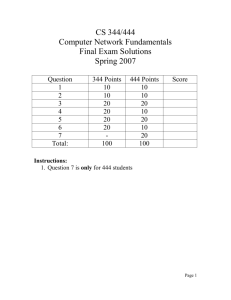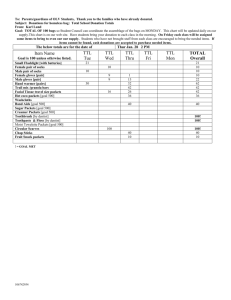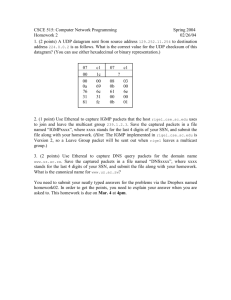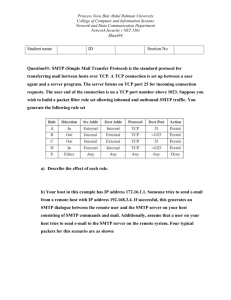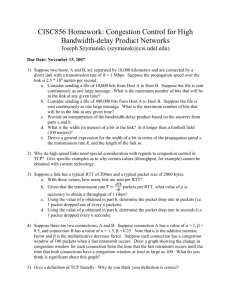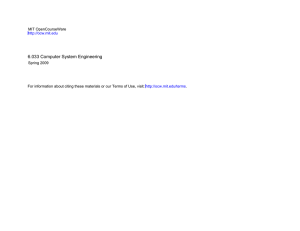CS 344/444 Computer Network Fundamentals Final Exam Solutions
advertisement
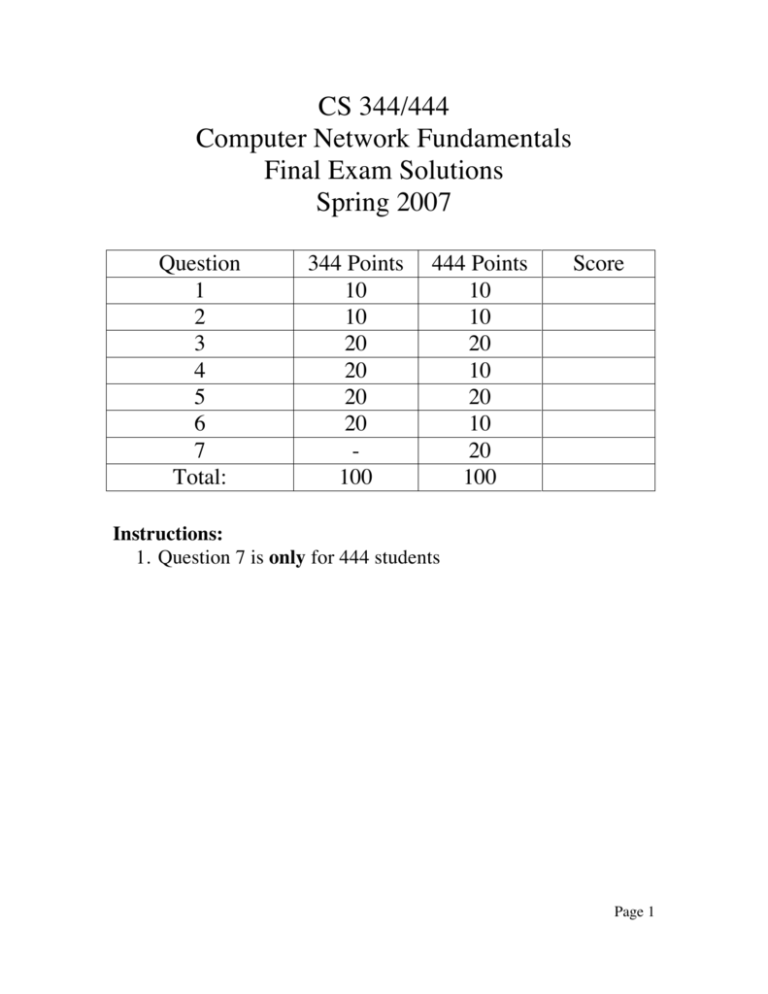
CS 344/444 Computer Network Fundamentals Final Exam Solutions Spring 2007 Question 1 2 3 4 5 6 7 Total: 344 Points 10 10 20 20 20 20 100 444 Points 10 10 20 10 20 10 20 100 Score Instructions: 1. Question 7 is only for 444 students Page 1 Question 1 (10 pt) (a) (5 pt) Explain the End to End argument. Do not implement functionality that can be implemented at the edges, in the core of the network unless it can be perfectly implemented and it does not create overhead for applications that don’t need it. (b) (5 pt) What is the special role of IP in the Internet protocol stack? How has this special role helped innovation in applications and physical transmission technologies? While multiple protocols exist above and below IP there is only IP at the network layer of the Internet architecture. This feature has enabled the develop of new applications and new transmission technologies because IP provides a compatibility layer. Question 2 (10 Points) Which of the following are true statements: a. The Slow-Start algorithm increases a source’s rate of transmission faster than "additive increase". TRUE b. A source’s retransmission timeout value (RTO) is always set equal to the measured RTT. FALSE c. If the RTO is too small, this might lead to unnecessary retransmissions. TRUE d. A source’s retransmission timeout value is set to a value that increases with the variance in measured RTT values. TRUE e. TCP segments can only be lost when router queues overflow. FALSE f. There is no performance benefit to having a window size (measured in seconds) larger than the RTT. TRUE g. A receiver reduces the advertised window size in response to congestion at routers along the path. FALSE Page 2 h. RED is tolerant of bursts because it never drops consecutive packets from the same flow. FALSE i. RED always drops packets, with probability 1, when the router’s average queue length is greater than the maximum threshold value. TRUE j. If two flows, one TCP and one UDP, share a "RED" router, the RED algorithm will ensure that both flows receive an identical share of the outgoing link. FALSE Question 3 (20 points) TCP Congestion Control. In this question we’ll find approximate equations for the throughput of the TCP AIMD mechanism. (a.) (5 points) Why does TCP use additive increase rather than multiplicative increase? Multiplicative increase would cause the network to be unstable. The graph below shows the "sawtooth" evolution of the TCP sender’s window size as a function of time. W is the maximum window size (measured in packets). In this question, assume that all packets are P bits long, and that exactly one packet is dropped every time the window size reaches W. (c.) (5 points) If we ignore the "slow-start" phase at the beginning of the flow, show that the average rate at which the transmitter sends packets is given by: packets per second RTT is the round-trip time, which we will assume is constant. Each transmitter sends one window's worth of data each RTT. The window size increases linearly from W/2 to W. So average length of transmit window . Page 3 (c.) (5 points) Show that the fraction of packets dropped, L, is given by the following expression: Hint: Remember that we’re assuming that exactly one packet is dropped every time the window size reaches W. In each period of the sawtooth, one packet is lost, and the transmitter sends packets; and the average window size is windows of . Therefore, 1 packet is lost for every that are transmitted. (d.) (5 points) Using your answers to (b) and (c), and assuming that W is very large, show that the average rate at which the transmitter sends is given by: bits per second Rearrange (c) to get packets, and substitute W into (b) to get: Question 4 (20 points) Consider a connection-oriented streaming data protocol that transmits voice over the network. Assume losses can be tolerated, delay and jitter are important, the stream should be sent at the highest quality that the network could support, and that the protocol is well behaved with respect to congestion. It works as follows. The sender establishes a connection with a receiver. The sender samples very high quality audio (64 kbps) and selectively produces packetized downsampled streams at low (8 kbps), medium (16 kbps), and high quality (32 kbps). The receiver measures the received stream rate, and reports this back to the sender periodically. Using this information, the sender determines Page 4 that it is experiencing congestion and sustaining losses to the receiver if the reported received rate is less than the transmitted rate. It responds to such congestion detection by moving to the next lower quality rate. Occasionally the sender attempts to move up in quality if the network can sustain a higher rate without encountering congestion. Logically, the basic protocol event flows are as follows: a. (5 points) What is the most critical advantage of this scheme compared with using TCP? This scheme reacts the congestion b. (5 points) What is the most critical advantage of this scheme compared with using UDP? This scheme reacts to packet losses c. (5 points) Briefly describe a method to compute the received rate. How frequently would you report the rate to the sender, and is there any reason for limiting the frequency such rate reports? Over a defined fixed time interval, compute the number of packets received and the number of payload bits in those packets. # bits / time = transmission rate in bps (1 point). Report the rate one in every few received packets (1 in 20 say) or once every few seconds (1 point). Reason is that we need several packets worth of data to get a reasonable rate calculation and also to limit the return bandwidth demand. d. (5 points) Briefly describe a method to determine when to increase the sending rate. What concern should you have about the pace at which you increase this? Set a threshold, say 10%, of the current sending rate. If received rate as reported back is less than or equal to sending rate – threshold, then reduce sending rate. Only Page 5 increase sending rate again if the network can successful transmit the current rate for several (say five) packets, as indicated by the returned rate reports (in other words, do not double the rate based only one packet getting through successfully!) Question 5 (20 points) a. (5 points) A large percentage of the DNS requests that arrive at the root DNS servers are requests for DNS domains that don’t exist (e.g. www.cs.jhu.edui). One way to reduce the load experienced by the root nameservers would be to use negative caching, that is the negative response returned by the nameserver would be cached at the local nameserver so subsequent requests would be answered locally. Explain the costs of this solutions and why it would not sufficiently reduce the load on the root nameservers due to non-existing domains. The hit rate would be very small. The cost is all the additional storage at the caching server required to cache all the bogus names. b. (5 points) What are the benefits of the hierarchical namespace in DNS? Scalability, matching organization structure and name conflict resolution. c. (5 points) A domain in DNS is served by multiple nameservers. Describe the two main benefits from having multiple nameservers. What factors determine whether these multiple nameservers will in practice deliver these benefits? Scalability and redundancy in the face of server and network failures. The multiple servers should fail independently and therefore should be located in different geographic locations and have separate connections to the Internet. d. (5 points) Denial of Service attacks against the root nameservers is a major problem these days. Given that no more than 13 IP addresses can be allocated for the root nameservers describe a solution to minimize the impact of DoS attacks. Anycast Question 6 (20 points) Consider the network shown below in which horizontal lines represent transit providers and numbered vertical lines are inter-provider links. Page 6 A Provider P 1 2 Provider Q 4 B 3 Provider R (a) (10 points) Suppose Q and P adopt the policy that outbound traffic is routed to the closest link to the destination's provider, thus minimizing their own cost. What paths will traffic from host A to host B and from host B to host A take? The traffic from A to B will cross link 1, while traffic from B to A will cross link 2. (b) (10 points) What could Q do to have the BA traffic use the closer link 1? Provider Q would have to effectively block the announcement from A that arrives through inter-domain link 2. This can be done by setting a local policy (e.g. precedence) that the announcement from link 1 is preferred over the announcement from link 2. Question 7 (20 points) Weighted Fair Queueing. The figure below shows n leaky-bucket flows multiplexed together onto a link at rate C bytes per second. The i-th leaky-bucket contains at most ki tokens; and new tokens arrive at rate ri tokens per second. One token is required for each byte transmitted into the network. Each flow has its own FCFS queue. Flow is served with weight wi by a WFQ scheduler. (a) (10 points) Assuming that the WFQ scheduler serves one byte at a time, prove that no queue will overflow if, and only if, (for all i): Page 7 Queue i is served at least at rate (possibly higher if some queues are empty). So long as the arrival rate is less than the service rate, the queue will not overflow. The arrival rate is constrained by the leaky bucket to be no greater than ri . Hence: (b) (10 points) Assuming that no queue overflows, show that the maximum queueing delay encountered by a byte is given by: Maximum queuing delay = max occupancy/min service rate. The minimum service rate was found in part (a). The maximum occupancy is determined by the leaky-bucket, which constraints the size of the instantaneous burst to ki . Page 8
